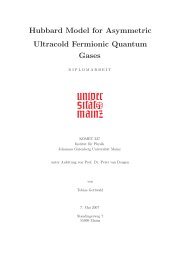5 Hirsch-Fye quantum Monte Carlo method for ... - komet 337
5 Hirsch-Fye quantum Monte Carlo method for ... - komet 337
5 Hirsch-Fye quantum Monte Carlo method for ... - komet 337
You also want an ePaper? Increase the reach of your titles
YUMPU automatically turns print PDFs into web optimized ePapers that Google loves.
<strong>Hirsch</strong>-<strong>Fye</strong> QMC 5.25<br />
(a) 0.0236<br />
(b)<br />
D<br />
0.0235<br />
0.0234<br />
0.0233<br />
0.0232<br />
0.0231<br />
0.023<br />
0.0229<br />
0.0228<br />
0 10 20 30 40 50 60 70<br />
it<br />
∆τ=0.12<br />
∆τ=0.15<br />
∆τ=0.18<br />
∆τ=0.20<br />
D<br />
0.024<br />
0.023<br />
0.022<br />
0 0.02 0.04<br />
∆τ<br />
0.06<br />
2<br />
Fig. 15: Steps in the HF-QMC based computation of the double occupancy atU = 5,T = 0.04:<br />
(a) estimates can be calculated as averages with statistical error bars from the analysis of time<br />
series (traces), taking autocorrelation into account, <strong>for</strong> each value of∆τ. (b) Numerically exact<br />
results are obtained in a second step using extrapolation by least-squares fits.<br />
be included in averages. Moreover, all curves show significant autocorrelation which has to<br />
be taken into account <strong>for</strong> error analysis. Taking these issues into account, standard analysis<br />
techniques <strong>for</strong> time series yield raw HF-QMC results <strong>for</strong> each value of the discretization plus<br />
an error bar which takes statistical and convergency error into account. Such data is shown in<br />
Fig. 15b as a function of the squared discretization. Evidently, the discretization dependence is<br />
very regular; a straight<strong>for</strong>ward extrapolation using standard least-square fit <strong>method</strong>s (here with<br />
the 3 free parameters corresponding to the orders ∆τ 0 , ∆τ 2 , and ∆τ 4 ) essentially eliminates<br />
this systematic error, i.e. reduces the total error by two orders of magnitude. 19<br />
Due to the cubic scaling of the ef<strong>for</strong>t with the number of time slices, the total cost of achieving<br />
extrapolated results <strong>for</strong> some grid range is dominated by the smallest discretization. Thus the<br />
possibility of extrapolation comes (with the use also of coarser grids) at no significant cost; in<br />
contrast, DMFT convergence can be accelerated by using the ∆τ hysteresis technique outlined<br />
above. Taking all of this into account, HF-QMC with extrapolation can be competitive with<br />
the recently developed continuous-time QMC solvers, as demonstrated in Fig. 16: at fixed total<br />
computer time, this <strong>method</strong> achieves the highest precision [47] in energy estimates <strong>for</strong> a test<br />
case established in [43].<br />
Note that the use of insufficiently converged solutions is potentially a very significant source of<br />
errors. It is important to realize that in principle measurements have to be per<strong>for</strong>med exactly at<br />
the solution of the self-consistency equations, i.e., <strong>for</strong> the exact bath Green function. Averages<br />
over measurements per<strong>for</strong>med <strong>for</strong> different impurity models corresponding to approximate solutions<br />
do not necessarily converge to the exact answer in the limit of an infinite number of<br />
models (i.e., iterations) and measurements. 20 Still, the most important practical point when<br />
19 The reader may note a similarity to the MC example shown in Fig. 3.<br />
20 Trivially, a measurement of the free energy F itself (using a suitable impurity solver) is a good example.<br />
Since F is minimal <strong>for</strong> the true solution, all measurements taken <strong>for</strong> approximate solutions will be too large. The<br />
correct answer can, there<strong>for</strong>e, not be approached by averaging over many measurements, but only by reducing the













